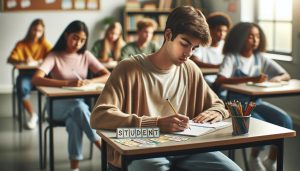As the world continues to navigate the aftermath of the COVID-19 pandemic, its profound impact on student learning remains a pressing concern. An estimated loss of one-third of a school year has negatively affected students’ academic performance and future earning potential, with possible long-term income declines of up to 3.5% across their working lives [[1]]. This article delves into how these disruptions have shaped educational experiences and what recovery strategies can be employed to support students in reclaiming their educational trajectories. With practical steps and insights, we aim to empower learners to overcome challenges, enhance their academic skills, and set the stage for a successful future. Join us as we explore effective recovery strategies that can guide students toward resilience and achievement in their educational journeys.
Understanding the Impact of COVID on Student Learning
The COVID-19 pandemic has profoundly reshaped the educational landscape, with lasting implications for student learning. One striking statistic reveals that there was a historic decline of 2.7% in public school enrollment in fall 2020, indicating that many students either disengaged from formal education or were unable to access it altogether during this tumultuous period[[3]](https://nces.ed.gov/surveys/annualreports/topical-studies/covid/). This disruption extended beyond immediate academic performance; it also laid bare existing inequities in the education system, as vulnerable populations faced disproportionately adverse outcomes.
Students encountered not only a shift to online learning but also a myriad of challenges that impacted their educational experience. The transition highlighted the gaps in technology access and digital literacy, as well as the varying levels of parental support and home learning environments. Indeed, research underscored that the pandemic’s impact on learning was multifaceted, driven by both school closures and broader social dynamics, emphasizing the urgent need for interventions tailored to these diverse challenges[[2]](https://www.gse.harvard.edu/ideas/news/23/05/new-data-show-how-pandemic-affected-learning-across-whole-communities).
To mitigate these effects and foster recovery, educators and policymakers are globally rethinking instructional practices. There is a growing recognition of the importance of adaptive teaching methods, targeted interventions, and mental health support to help students regain lost ground. Practical solutions include the implementation of personalized learning plans that cater to individual strengths and challenges, alongside restoring face-to-face instruction that blends social interaction with academic rigor. By embracing a collaborative approach that includes schools, families, and communities, we can build a more resilient educational framework that not only addresses current gaps but also equips students with the skills to thrive in an ever-evolving world.
In navigating these recovery strategies, it’s essential to focus on holistic student well-being-embracing not only academic recovery but also fostering emotional health and resilience. Schools that prioritize a supportive environment and engage students meaningfully will be better positioned to counteract the adverse effects of the pandemic and foster a more equitable and effective learning atmosphere for all.
The Psychological Effects of COVID on Students
The profound psychological effects of the COVID-19 pandemic on students have brought to light the intricate link between mental health and academic success. With significant disruptions to their daily routines, many students experienced increased levels of stress, anxiety, and uncertainty about their future. A staggering proportion of students reported feeling overwhelmed by the changes, and for some, this led to feelings of loneliness and isolation that hindered their motivation to learn. Addressing these mental health challenges is crucial, not only for immediate recovery but also for long-term academic resilience.
To help combat these psychological effects, schools and educators can implement several supportive strategies. First, open communication is essential; creating an environment where students feel safe to express their feelings and concerns can significantly reduce anxiety. Regular check-ins, whether through surveys or one-on-one meetings, can help identify students in need of support. Moreover, integrating social-emotional learning programs into the curriculum can equip students with tools to manage their emotions and build resilience.
In addition to institutional support, students can adopt personal strategies to enhance their mental well-being. Establishing a routine that mimics a typical school day can provide structure, while making time for physical activity, hobbies, and social interactions-whether online or in-person-can improve mood and reduce feelings of isolation. Practicing mindfulness techniques, such as meditation or deep-breathing exercises, can also help students manage stress and maintain focus.
Recognizing and addressing the psychological effects of the pandemic is paramount to helping students not only recover but also thrive in their academic journeys. By fostering a compassionate and supportive learning environment, both educators and students can build a community that prioritizes mental health, ensuring that all learners have the opportunity to succeed both academically and personally.
Changes in Learning Environments During the Pandemic
The abrupt shift to remote and hybrid learning environments during the COVID-19 pandemic has reshaped the educational landscape in unprecedented ways. Many students suddenly found themselves navigating new digital platforms and communication tools, all while coping with the emotional and psychological toll of a global crisis. The transition exposed not only the technological disparities among students but also highlighted varying levels of readiness and adaptability to online learning.
As physical classrooms shifted to virtual settings, educators had to adapt lesson plans to be conducive to remote engagement. Newly formed habits around learning emerged; for instance, students began to develop self-directed learning skills. However, this transition didn’t come without significant challenges. Many students faced issues such as suboptimal learning environments at home, where distractions and lack of resources hampered their ability to focus. Furthermore, some struggled with the absence of direct peer interaction, which had previously played a critical role in their social and academic development.
In response to these shifts, educational institutions have launched initiatives aimed at incorporating more interactive and engaging content into online learning. Here are some effective strategies and tools that have emerged:
- Interactive Platforms: Tools like Kahoot! and Quizlet have allowed educators to create interactive quizzes that not only assess student learning but also make learning fun and engaging.
- Virtual Breakout Rooms: Enhancing collaborative learning, platforms like Zoom offer breakout rooms where students can work in small groups, fostering teamwork and deeper discussions, similar to what might happen face-to-face.
- Asynchronous Learning Opportunities: Many schools have recognized the importance of flexibility, offering recorded lectures and self-paced assignments, allowing students to learn at their own rhythm.
Implementing these changes has not only aided in immediate recovery following the onset of the pandemic but has the potential to enrich educational practices going forward. By capitalizing on the lessons learned from these experiences, both educators and students can cultivate a more resilient and adaptive learning atmosphere that embraces innovation and inclusivity. Understanding these new dynamics is essential for students as they strive to find their footing in an evolving educational environment, ultimately positioning themselves for success in this new era of learning.
Inequities in Education Exposed by COVID-19
The COVID-19 pandemic has spotlighted significant inequities in education that have long existed within the American educational system. As schools transitioned to online and hybrid learning models, many students faced disparities that significantly impacted their ability to engage with and succeed in their studies. For example, students from lower socioeconomic backgrounds often lacked reliable access to the internet and necessary digital devices, creating barriers to online learning. Research indicates that these pre-existing inequities were exacerbated by the pandemic, disproportionately affecting students of color and those from underserved communities, pushing them further behind their peers in terms of academic performance and engagement [[2]].
Having identified these challenges, educators and policymakers are now confronted with the critical task of addressing these inequalities to facilitate meaningful recovery in the post-pandemic landscape. It’s essential for schools to proactively implement strategies that ensure all students have equitable access to resources and support systems. This might involve creating comprehensive outreach programs designed to assist disadvantaged families in securing technology and internet access, as well as providing tutors or mentoring programs focused on those who fell behind during the disruptions [[1]].
Moreover, schools can consider adopting inclusive pedagogical practices that recognize the diverse backgrounds of students. For example, implementing differentiated instruction methodologies can support varying learning needs and styles, ultimately fostering a more equitable classroom environment. Engaging parents and communities in education-by establishing clear communication channels and resources-can also empower families to take a more active role in their children’s education during recovery efforts. By collaboratively working with all stakeholders, from educators and administrators to families and community organizations, a robust and inclusive recovery strategy can be cultivated that not only addresses the immediate aftermath of the pandemic but also redefines education equity for the future.
As education continues to evolve in response to these unprecedented challenges, it is vital for both immediate recovery and long-term educational reform to resonate with the lessons learned from the pandemic, ensuring that every student receives the support they need to thrive.
Adapting to Online Learning: Challenges and Solutions
The transition to online learning during the COVID-19 pandemic presented a myriad of challenges for students, educators, and families alike. As schools shuttered and classrooms shifted to virtual spaces, many students found themselves grappling with a steep learning curve. For instance, nearly half of students reported difficulties in engaging with online lessons, due in part to technical issues, lack of motivation, and distractions at home. Understanding these challenges is crucial for developing effective solutions that foster academic resilience.
To tackle these hurdles, schools and educators have implemented strategies that promote a more engaging and supportive online environment. Here are some key approaches:
Customized Learning Experiences
Adapting to online learning requires recognizing that every student has unique needs. Personalized learning plans can enhance student engagement by aligning coursework with individual interests and learning styles. For example, offering students choices in assignments or allowing them to explore topics that fascinate them can increase motivation and investment in their education.
Technology Training and Support
Many students, particularly those from underserved communities, face obstacles related to technology access and skills. Schools can bridge this gap by providing training sessions that teach students how to effectively use digital tools. Offering resources such as “how-to” guides for navigating learning platforms can empower students to take charge of their educational journey. Additionally, establishing tech support channels can help address issues as they arise, ensuring that students can focus on their studies instead of technical difficulties.
Creating a Collaborative Community
Online learning can often feel isolating. Fostering a sense of community is critical. Implementing virtual meet-ups, study groups, or buddy systems can help students connect with peers, share ideas, and support one another. Group projects and collaborative assignments can also encourage teamwork and communication, vital skills for both academic and personal success.
Mindfulness and Mental Health Resources
The emotional toll of the pandemic cannot be overstated, and positive mental health is essential for academic success. Schools should integrate mindfulness practices and provide access to counseling services. Encouraging students to engage in stress-reduction techniques, such as meditation or exercise, can help them manage anxiety related to their studies and foster a resilient mindset.
In conclusion, adapting to online learning requires a multifaceted approach that addresses technological challenges, fosters community engagement, and emphasizes the importance of mental well-being. By focusing on these areas, educators and students can navigate the post-pandemic educational landscape more effectively, ensuring that all students have the opportunity to thrive academically and personally.
Effective Recovery Strategies for Academic Performance
As we emerge from the disruptions caused by the COVID-19 pandemic, the need for effective recovery strategies in academic performance becomes increasingly evident. Students faced unprecedented challenges that impacted their learning trajectories and emotional well-being. However, armed with the right approaches, students can not only recover lost ground but also emerge stronger, more adaptable, and better prepared for future challenges.
A critical strategy for academic recovery involves utilizing targeted instruction to address specific learning gaps. Teachers can conduct assessments to identify areas where students may need additional support or enrichment. By tailoring lessons that focus on these areas, educators can help students regain confidence and competence in their studies. Furthermore, peer tutoring can be a powerful tool; when students collaborate to teach and learn from each other, it promotes deeper understanding and retention of material.
Encouraging a Growth Mindset
Cultivating a growth mindset is essential for fostering resilience among students. By encouraging the belief that abilities and intelligence can be developed through hard work and dedication, educators can help students embrace challenges and recover from setbacks. Practical strategies include celebrating effort over results, providing constructive feedback, and encouraging students to set specific, achievable goals. For instance, rather than merely focusing on grades, teachers can celebrate improvements in effort and learning behaviors, reinforcing the idea that growth is a continuous journey.
Integrating Mental Health Support
Recovery from academic setbacks cannot be divorced from mental health considerations. The emotional toll of the pandemic has left many students dealing with anxiety and stress, which can hinder their academic performance. Schools should prioritize mental health resources, such as counseling services, mindfulness programs, and wellness workshops. For students at home, establishing a structured daily routine can provide stability, while incorporating physical activity, creative outlets, and relaxation techniques can help manage stress and improve focus.
Leveraging Technology Wisely
Technology, while a source of distraction during the pandemic, can also be a valuable tool for recovery. Utilizing educational platforms that offer interactive and engaging content can capture students’ interest and enhance learning. Online resources can provide access to supplemental materials and varied instructional approaches, catering to different learning styles. Furthermore, scheduling regular check-ins and online study sessions can help maintain accountability and support as students navigate their recovery journey together.
By implementing these strategies, students can chart a path toward academic recovery that not only addresses past challenges but also equips them with the skills and mindset necessary for future success. The emphasis on personalized learning, mental well-being, and the embrace of a flexible, growth-focused approach ensures that students are not merely surviving but thriving in a rapidly changing educational landscape.
Enhancing Student Engagement in a Post-Pandemic World
While the pandemic drastically altered the educational landscape, it also unveiled new opportunities for student engagement that can be harnessed in our ever-evolving post-pandemic world. As students return to campuses, many are navigating a complex array of emotions and experiences shaped by their time away from traditional learning environments. Understanding this context is essential for revitalizing engagement strategies that inspire students to connect meaningfully with their academic and social environments.
A recent report illustrates that while student engagement in on-campus activities has shown signs of recovery since 2020, it still remains lower than pre-pandemic levels. This highlights the ongoing challenge of re-engaging students who may feel disconnected or apprehensive about fully participating in college life again [[2]]. One effective approach to fostering engagement is to revamp extracurricular offerings. By creating flexible, hybrid options that cater to varied student preferences (both in-person and online), institutions can encourage greater participation from those hesitant to engage face-to-face. Events like virtual meet-and-greets, online discussion forums, and socially-distanced outdoor activities can spark interest among students while they adjust to campus life.
Moreover, the importance of integrating academic and social opportunities cannot be overstated. Researchers recommend that institutions emphasize research opportunities, community connections, and career development programs [[2]]. Creating projects that allow students to collaborate on real-world problems not only enhances engagement but also fosters a sense of purpose and belonging. Institutions can facilitate this by partnering with local organizations or businesses to offer internships and service-learning opportunities that resonate with students’ career aspirations.
To further enhance student involvement, it’s crucial to leverage technology as a facilitator rather than a barrier. Interactive platforms that host discussions, provide feedback, and create community among students can bridge gaps that arose during remote learning. Utilizing apps and online tools that promote student organization, networking, and project collaboration can ease the transition for those who might feel overwhelmed by the shift back to a fully in-person environment.
As we navigate this post-pandemic reality, fostering student engagement requires a creative blend of tradition and innovation. By listening to student feedback, adapting to their evolving needs, and ensuring all voices are heard, educational institutions can create dynamic environments where students not only recover from past disruptions but also thrive academically and personally.
Mental Health Support for Students Recovering from COVID
The challenges posed by the COVID-19 pandemic have extended beyond academics, significantly impacting students’ mental health. With disruptions in daily routines, isolation from peers, and the uncertainty enveloping education, many students have experienced feelings of anxiety, depression, and stress. As institutions pivot back to normalcy, providing robust mental health support is essential for helping students navigate this recovery period successfully.
To create an environment conducive to mental wellness, schools and universities should focus on increasing accessibility to mental health resources. This includes expanding counseling services, offering virtual therapy options, and providing workshops centered around stress management, coping strategies, and resilience building. Regular check-ins by faculty and support staff can also create a culture of care, ensuring students feel safe and supported. Peer support groups can foster community and encourage open discussions about mental health, allowing students to share their experiences and coping mechanisms.
Moreover, integrating mental health awareness into the academic curriculum can help normalize conversations around mental well-being. Educational programs that teach students about emotional intelligence, mindfulness practices, and the importance of self-care can empower them with the tools they need to manage their mental health effectively. Providing platforms for students to engage in creative expression-be it through art, writing, or music-can also serve as an effective outlet for processing their emotions.
In addition to institutional support, students should be encouraged to take proactive steps in caring for their mental well-being. Simple practices such as maintaining a regular sleep schedule, engaging in physical activity, and fostering social connections-even if virtually-can contribute significantly to mental health. By sharing practical tips and encouraging peer accountability, schools can help cultivate a supportive atmosphere where students work together to prioritize their well-being and recovery.
Ultimately, the goal is to assist students in recognizing and articulating their mental health needs, ensuring they possess the necessary resources and support to thrive in a post-pandemic world. This multifaceted approach not only aids in recovery from COVID-related disruptions but also fosters a resilient and prepared student body for future challenges.
Building Resilience: Skills for Future Challenges
The ability to recover from disruptions and adapt to new challenges is a vital skill for students as they navigate post-pandemic education. Resilience isn’t merely the ability to bounce back; it encompasses the capacity to grow and thrive despite adversity. As students emerge from the pandemic’s shadow, cultivating resilience can empower them to face academic, social, and emotional obstacles with confidence.
One practical approach to building resilience is fostering a growth mindset. This involves encouraging students to view challenges as opportunities for learning rather than insurmountable obstacles. Workshops or classes on growth mindset principles can equip students with strategies for reframing negative thoughts, celebrating small achievements, and maintaining their motivation. By learning that effort and persistence can lead to improvement, students can reduce academic anxiety and empower themselves to tackle difficult subjects or projects.
Incorporating mindfulness practices into daily routines can also bolster resilience. Mindfulness teaches students to stay present and manage their stress effectively. Techniques such as meditation, deep breathing exercises, and reflective journaling can help students gain clarity and emotional awareness. Schools can introduce mindfulness sessions or clubs that encourage peer support and sharing of experiences. This not only aids individual coping but helps build a community where challenges are acknowledged and addressed collectively.
Furthermore, establishing solid support networks is crucial. Creating spaces where students can engage in open dialogue-be it through mentorship programs, peer-led support groups, or faculty check-ins-can create a sense of belonging. Such relationships allow students to share their experiences, find camaraderie in shared struggles, and build the social capital essential for navigating future hurdles. By emphasizing connection and collaboration, institutions can cultivate an environment that nurtures resilience among students, equipping them with the skills required to face challenges both in their academic journeys and in life beyond school.
Success Stories: Students Thriving Post-COVID
The pandemic presented an unprecedented challenge for students worldwide, yet many have emerged from this experience with inspiring stories of resilience and growth. These success stories demonstrate that, despite significant setbacks, students have adapted, persevered, and even thrived in their educational journeys.
One notable example comes from a group of high school students in California who turned the adversity of remote learning into an opportunity for innovation. Faced with the challenge of disengagement during online classes, this student-led initiative organized virtual study groups that emphasized collaboration and peer support. Utilizing online platforms, they created a series of subject-specific workshops where students could share resources, tackle difficult concepts together, and develop new study techniques. Not only did this initiative enhance academic performance, but it also fostered a sense of community and belonging, which was crucial during a time of isolation.
Similarly, a university student in Australia found their footing during the chaotic shift to online classes by creating a mental health support group. Recognizing the mental toll the pandemic was taking on their peers, they initiated weekly virtual meetups that provided a space for students to share their experiences and strategies for coping with stress. Through guided discussions and mindfulness exercises, this group strengthened not only the participants’ mental well-being but also their academic focus, helping many students raise their grades as they felt supported in managing their mental health challenges.
These examples underscore key strategies that can aid recovery and promote success in the post-pandemic educational landscape.
Practical Strategies for Thriving Post-COVID
- Peer Collaboration: Engaging in study groups can deepen understanding and bolster performance, making learning a shared responsibility.
- Mental Health Initiatives: Creating or participating in support groups can significantly alleviate stress and anxiety, leading to improved academic results.
- Utilizing Technology: Leveraging digital tools for learning, collaboration, and mental health support allows students to connect and share resources effectively.
- Growth Mindset Workshops: Participating in or organizing workshops focused on fostering resilience can help students reframe challenges and unlock their full potential.
As students continue to face the aftermath of the pandemic, these success stories remind us that adaptation and community engagement can lead to extraordinary transformations. By cultivating supportive environments and leveraging shared experiences, students can pave their way to academic and personal success in a post-COVID world.
Educational Tools and Resources for Recovery
The transition back to traditional learning environments after the disruptions caused by COVID-19 has highlighted the need for robust educational tools and resources to support students in their recovery journey. With many students experiencing significant learning loss-a report from NWEA indicates that students may need more than four months of additional schooling in reading and math-it’s vital that educational stakeholders provide the necessary tools to bridge these gaps and foster success in the classroom and beyond [[1]].
Innovative online platforms can be game-changers in this context. Tools like Khan Academy offer free courses and resources that allow students to revisit concepts at their own pace, giving them the chance to solidify their understanding. Additionally, schools can implement learning management systems (LMS) such as Google Classroom or Moodle, which facilitate better communication between students and teachers, manage assignments efficiently, and provide a centralized hub for sharing educational materials. These platforms enable interactive learning experiences that can help maintain engagement and motivation in a post-pandemic world.
Moreover, integrating mental health resources into educational frameworks is crucial. Students carrying the psychological burden of isolation or anxiety can benefit from services like TherapyChat or online counseling platforms, which connect them with mental health professionals. Schools can also establish initiatives that focus on mindfulness and emotional resilience, helping students to navigate the challenges they face with the support they need.
To ensure effective recovery, educational institutions should encourage a culture of collaboration among students, parents, and educators. This can be achieved through workshops that guide parents on how to support their children’s learning at home, or community-driven initiatives that bring together diverse resources and expertise. By fostering a supportive community alliance, schools can create an environment where every student feels valued and encouraged to thrive academically and personally.
In summary, leveraging technology, providing access to mental health resources, and promoting collaboration between families and schools will pave a proactive path toward recovery. By harnessing these educational tools and resources, students can not only overcome academic setbacks but also develop the resilience and skills necessary to tackle future challenges with confidence.
Collaborative Approaches: Schools, Parents, and Students
Building strong partnerships between schools, parents, and students is essential to overcoming the challenges brought on by the COVID-19 pandemic. Collaborative efforts can create an environment where students feel supported and motivated to engage in their learning, ultimately improving their academic and emotional well-being. One captivating fact is that research shows that when parents actively participate in their children’s education, student achievement increases significantly. This collaboration can take various forms, enriching the educational experience and addressing the unique needs of each student.
Strategies for Effective Collaboration
- Regular Communication: Schools should establish consistent channels of communication with parents-whether through newsletters, social media updates, or parent-teacher conferences. This encourages parents to stay informed about their child’s progress and allows educators to share resources and strategies that can be implemented at home.
- Workshops and Training: Organizing workshops for parents on topics like online learning tools, academic support techniques, and mental health awareness can empower them to assist their children more effectively. For example, sessions that teach parents how to use educational platforms can help them guide their children through challenges they may face.
- Engaging Students in Dialogue: Encouraging students to share their experiences, thoughts, and challenges with both their peers and parents fosters a sense of ownership over their learning. Schools can create safe spaces for discussions, such as student-led meetings or forums, where students feel comfortable expressing their needs and expectations.
Creating a unified support system not only addresses academic setbacks but also promotes emotional resilience. Schools can implement mentorship programs where older students guide younger ones, creating a bond that enhances their learning experience. This applies knowledge-sharing in many forms, such as homework help or providing tips for managing stress, which becomes particularly essential during recovery from the pandemic’s aftermath.
In addition, leveraging technology can significantly enhance collaboration. Platforms like ClassDojo or Remind can facilitate real-time communication between educators and families, making it easier to track progress and address concerns swiftly. By ensuring that everyone is on the same page, these tools contribute to a cohesive strategy aimed at nurturing student success.
Ultimately, building a collaborative triad of schools, parents, and students lays the foundation for a supportive educational ecosystem. With mutual commitment, shared resources, and clear communication, students can effectively navigate the complexities of post-pandemic recovery. Strengthening these bonds not only benefits academic performance but also instills skills in adaptability and resilience-qualities that will serve them well long into the future.
Frequently asked questions
Q: How did COVID-19 disrupt student learning?
A: COVID-19 disrupted student learning by closing schools, forcing shifts to online learning, and diminishing engagement. Students faced significant academic setbacks, particularly in reading and math, with many experiencing increased mental health challenges due to isolation and uncertainty. For more insights, see our section on “Understanding the Impact of COVID on Student Learning.”
Q: What are effective strategies for recovering student learning lost during the pandemic?
A: Effective recovery strategies include targeted tutoring, personalized learning plans, and increasing access to educational resources. Schools can also enhance engagement through collaborative projects and improved mental health support systems. Exploring “Effective Recovery Strategies for Academic Performance” can provide detailed approaches.
Q: How can parents support their children’s learning recovery post-COVID?
A: Parents can support learning recovery by creating structured routines, providing a conducive study environment, and encouraging open communication about academic challenges. Engaging with teachers and participating in school activities can further enhance support. Check out “Collaborative Approaches: Schools, Parents, and Students” for more ideas.
Q: What role does mental health play in students’ recovery from COVID disruptions?
A: Mental health plays a critical role in students’ recovery by influencing their motivation, engagement, and overall well-being. Providing accessible mental health resources and fostering a supportive environment are key to helping students thrive post-pandemic. Refer to our section on “Mental Health Support for Students Recovering from COVID” for strategies.
Q: What challenges do schools face in re-engaging students after the pandemic?
A: Schools face challenges such as addressing learning gaps, dealing with varying levels of academic performance, and rebuilding social connections among students. Schools must implement tailored programs to re-engage students effectively. Insights can be found in “Enhancing Student Engagement in a Post-Pandemic World.”
Q: How did online learning impact student performance during COVID-19?
A: Online learning significantly impacted student performance, leading to declines in academic achievement, especially for disadvantaged students. Many struggled with technology access and self-discipline in remote environments. For a deeper understanding, see “Adapting to Online Learning: Challenges and Solutions.”
Q: What resources are available for students to aid in their academic recovery?
A: There are numerous resources available, including online tutoring platforms, educational apps, and community programs focused on supporting student learning. Schools can also offer workshops and mentoring programs to assist recovery. The section on “Educational Tools and Resources for Recovery” discusses available options.
Q: Why are some students thriving post-COVID while others struggle?
A: Differences in home support, access to resources, and individual resilience contribute to the disparity in student outcomes post-COVID. Those with strong family backing and learning resources tend to fare better. For success stories and insights, check “Success Stories: Students Thriving Post-COVID.”
To Wrap It Up
As we conclude our exploration of how COVID-19 has reshaped student learning, it’s clear that proactive recovery strategies are essential for academic success. Equip yourself with the right tools and resources to mitigate learning loss and harness new educational methods that promote resilience and adaptability. We encourage you to delve into our articles on study techniques and mental wellness to further support your academic journey.
Don’t let uncertainty hold you back-consider signing up for our newsletter to stay informed about the latest insights on education recovery, financial management, and scholarships. Engage with us by sharing your thoughts in the comments or browsing our comprehensive guides on university admissions and budgeting for students. Your success story starts with action today, so let’s shape a brighter future together.









